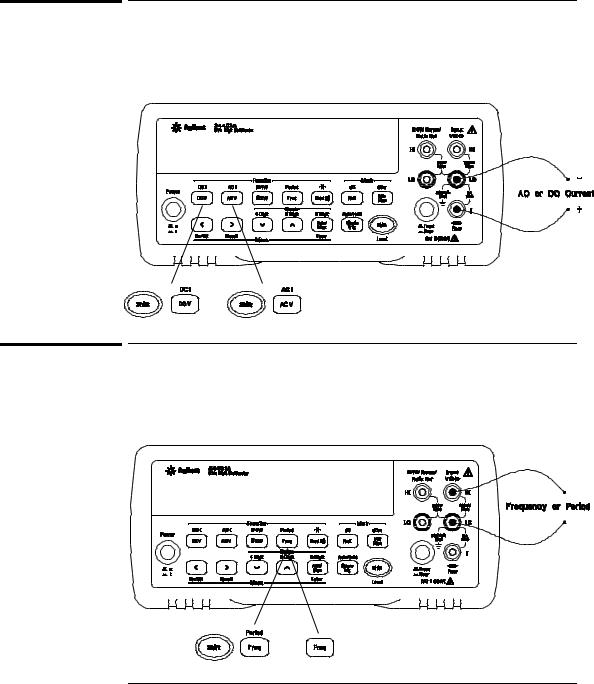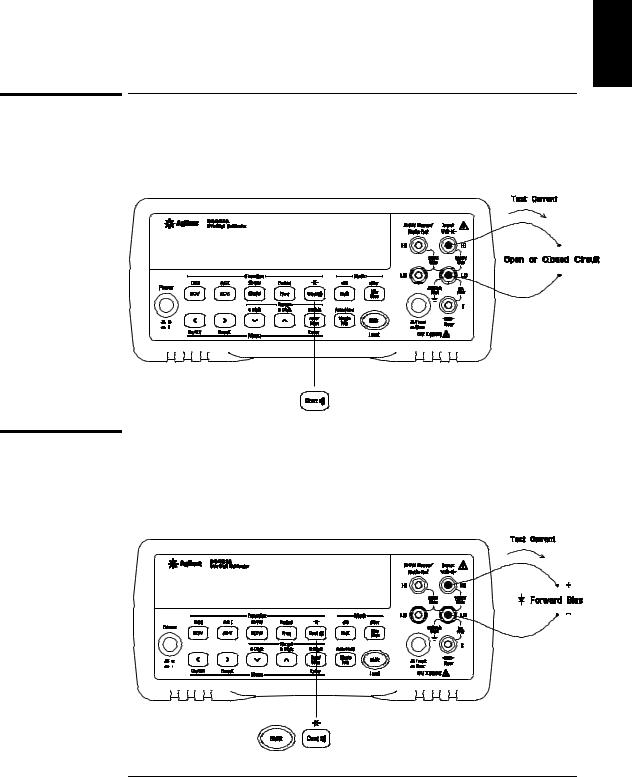
- •Contents
- •In This Book
- •To Prepare the Multimeter for Use
- •If the Multimeter Does Not Turn On
- •To Adjust the Carrying Handle
- •To Measure Voltage
- •To Measure Resistance
- •To Measure Current
- •To Measure Frequency (or Period)
- •To Check Diodes
- •To Select a Range
- •To Set the Resolution
- •Front-Panel Display Formats
- •To Rack Mount the Multimeter
- •Front-Panel Menu Reference
- •A Front-Panel Menu Tutorial
- •Messages Displayed During Menu Use
- •Menu Example 1
- •Menu Example 2
- •Menu Example 3
- •To Turn Off the Comma Separator
- •To Make Null (Relative) Measurements
- •To Store Minimum and Maximum Readings
- •To Make dB Measurements
- •To Make dBm Measurements
- •To Trigger the Multimeter
- •To Use Reading Hold
- •To Make dcv:dcv Ratio Measurements
- •To Use Reading Memory
- •Measurement Configuration
- •Math Operations
- •Triggering
- •System-Related Operations
- •Remote Interface Configuration
- •Calibration Overview
- •Operator Maintenance
- •Power-On and Reset State
- •Command Summary
- •Simplified Programming Overview
- •Using the MEASure? Command
- •Using the CONFigure Command
- •Using the range and resolution Parameters
- •Using the READ? Command
- •Using the INITiate and FETCh? Commands
- •The MEASure? and CONFigure Commands
- •Measurement Configuration Commands
- •Math Operation Commands
- •Triggering
- •Agilent 34401A Triggering System
- •The Wait-for-Trigger State
- •Triggering Commands
- •System-Related Commands
- •The SCPI Status Model
- •What is an Event Register?
- •What is an Enable Register?
- •SCPI Status System
- •The Status Byte
- •Using *STB? to Read the Status Byte
- •To Interrupt Your Bus Controller Using SRQ
- •To Determine When a Command Sequence is Completed
- •How to Use the Message Available Bit (MAV)
- •Using *OPC to Signal When Data is in the Output Buffer
- •The Standard Event Register
- •The Questionable Data Register
- •Status Reporting Commands
- •Calibration Commands
- •RS-232 Interface Configuration
- •RS-232 Configuration Overview
- •RS-232 Data Frame Format
- •Connection to a Computer or Terminal
- •RS-232 Troubleshooting
- •RS-232 Interface Commands
- •An Introduction to the SCPI Language
- •Command Format Used in This Manual
- •Command Separators
- •Using the MIN and MAX Parameters
- •Querying Parameter Settings
- •SCPI Command Terminators
- •IEEE-488.2 Common Commands
- •SCPI Parameter Types
- •Numeric Parameters
- •Discrete Parameters
- •Boolean Parameters
- •String Parameters
- •Output Data Formats
- •Using Device Clear to Halt Measurements
- •TALK ONLY for Printers
- •To Set the GPIB Address
- •To Select the Remote Interface
- •To Set the Baud Rate
- •To Set the Parity
- •To Select the Programming Language
- •Alternate Programming Language Compatibility
- •Agilent 3478A Language Setting
- •Fluke 8840A/8842A Language Setting
- •SCPI Compliance Information
- •IEEE-488 Compliance Information
- •Execution Errors
- •Self-Test errors
- •Calibration Errors
- •Using MEASure? for a Single Measurement
- •Using CONFigure with a Math Operation
- •Using the Status Registers
- •RS-232 Operation Using QuickBASIC
- •RS-232 Operation Using Turbo C
- •Thermal EMF Errors
- •Loading Errors (dc volts)
- •Leakage Current Errors
- •Rejecting Power-Line Noise Voltages
- •Common Mode Rejection (CMR)
- •Noise Caused by Ground Loops
- •Resistance Measurements
- •4-Wire Ohms Measurements
- •Removing Test Lead Resistance Errors
- •Power Dissipation Effects
- •Settling Time Effects
- •Errors in High Resistance Measurements
- •DC Current Measurement Errors
- •True RMS AC Measurements
- •Crest Factor Errors (non-sinusoidal inputs)
- •Loading Errors (ac volts)
- •Measurements Below Full Scale
- •High-Voltage Self-Heating Errors
- •Temperature Coefficient and Overload Errors
- •Low-Level Measurement Errors
- •Common Mode Errors
- •AC Current Measurement Errors
- •Frequency and Period Measurement Errors
- •Making High-Speed DC and Resistance Measurements
- •Making High-Speed AC Measurements
- •DC Characteristics
- •AC Characteristics
- •Frequency and Period Characteristics
- •General Information
- •Product Dimensions
- •To Calculate Total Measurement Error
- •Total Measurement Error
- •Interpreting Multimeter Specifications
- •Number of Digits and Overrange
- •Sensitivity
- •Resolution
- •Accuracy
- •Transfer Accuracy
- •24-Hour Accuracy
- •90-Day and 1-Year Accuracy
- •Temperature Coefficients
- •Configuring for Highest Accuracy Measurements
- •DC Voltage, DC Current, and Resistance Measurements
- •AC Voltage and AC Current Measurements
- •Frequency and Period Measurements
- •Index

Chapter 1 Quick Start
To Measure Voltage
1
To Measure Voltage
Ranges: 100 mV, 1 V, 10 V, 100 V, 1000 V (750 Vac)
Maximum resolution: 100 nV (on 100 mV range)
AC technique: true RMS, ac-coupled
To Measure Resistance
Ranges: 100 Ω, 1 kΩ , 10 kΩ , 100 kΩ , 1 MΩ , 10 MΩ , 100 MΩ Maximum resolution: 100 µΩ (on 100 ohm range)
17

Chapter 1 Quick Start
To Measure Current
To Measure Current
Ranges: 10 mA (dc only), 100 mA (dc only), 1 A , 3 A Maximum resolution: 10 nA (on 10 mA range)
AC technique: true RMS, ac-coupled
To Measure Frequency (or Period)
Measurement band: 3 Hz to 300 kHz (0.33 sec to 3.3 sec) Input signal range: 100 mVac to 750 Vac
Technique: reciprocal counting
18

Chapter 1 Quick Start
To Test Continuity
1
To Test Continuity
Test current source: 1 mA |
|
|
|
|
|
|
|
|
|
|
|
|
|
|
|
|
|
|
|
|
|
|
|
|
|
|
|
|
|||||||||||
Maximum resolution: 0.1 |
Ω |
(range is fixed at 1 kohm) |
|||||||||||||||||||||||||||||||||||||
Beeper threshold: 1 Ω to |
|
|
1000 Ω ( beeps below adjustable threshold) |
||||||||||||||||||||||||||||||||||||
|
|
|
|
|
|
|
|
|
|
|
|
|
|
|
|
|
|
|
|
|
|
|
|
|
|
|
|
|
|
|
|
|
|
|
|
|
|
|
|
|
|
|
|
|
|
|
|
|
|
|
|
|
|
|
|
|
|
|
|
|
|
|
|
|
|
|
|
|
|
|
|
|
|
|
|
|
|
|
|
|
|
|
|
|
|
|
|
|
|
|
|
|
|
|
|
|
|
|
|
|
|
|
|
|
|
|
|
|
|
|
|
|
|
|
|
|
|
|
|
|
|
|
|
|
|
|
|
|
|
|
|
|
|
|
|
|
|
|
|
|
|
|
|
|
|
|
|
|
|
|
|
|
|
|
|
|
|
|
|
|
|
|
|
|
|
|
|
|
|
|
|
|
|
|
|
|
|
|
|
|
|
|
|
|
|
|
|
|
|
|
|
|
|
|
|
|
|
|
|
|
|
|
|
|
|
|
|
|
|
|
|
|
|
|
|
|
|
|
|
|
|
|
|
|
|
|
|
|
|
|
|
|
|
|
|
|
|
|
|
|
|
|
|
|
|
|
|
|
|
|
|
|
|
|
|
|
|
|
|
|
|
|
|
|
|
|
|
|
|
|
|
|
|
|
|
|
|
|
|
|
|
|
|
|
|
|
|
|
|
|
|
|
|
|
|
|
|
|
|
|
|
|
|
|
|
|
|
|
|
|
|
|
|
|
|
|
|
|
|
|
|
|
|
|
|
|
|
|
|
|
|
|
|
|
|
|
|
|
|
|
|
|
|
|
|
|
|
|
|
|
|
|
|
|
|
|
|
|
|
|
|
|
|
|
|
|
|
|
|
|
|
|
|
|
|
|
|
|
|
|
|
|
|
|
|
|
|
|
|
|
|
|
|
|
|
|
|
|
|
|
|
|
|
|
|
|
|
|
|
|
|
|
|
|
|
|
|
|
|
|
|
|
|
|
|
|
|
|
|
|
|
|
|
|
|
|
|
|
|
|
|
|
|
|
|
|
|
|
|
|
|
|
|
|
|
|
|
|
|
|
|
|
|
|
|
|
|
|
|
|
|
|
|
|
|
|
|
|
|
|
|
|
|
|
|
|
|
|
|
|
|
|
|
|
|
|
|
|
|
|
|
|
|
|
|
|
|
|
|
|
|
|
|
|
|
|
|
|
|
|
|
|
|
|
|
|
|
|
|
|
|
|
|
|
|
|
|
|
|
|
|
|
|
|
|
|
|
|
|
|
|
|
|
|
|
|
|
|
|
|
|
|
|
|
|
|
|
|
|
|
|
|
|
|
|
|
|
|
|
|
|
|
|
|
|
|
|
|
|
|
|
|
|
|
|
|
|
|
|
To Check Diodes
Test current source: 1 mA
Maximum resolution: 100 µV range( is fixed at 1 Vdc)
Beeper threshold: 0.3 volts ≤ Vmeasured ≤ 0.8 volts (not adjustable)
19

Chapter 1 Quick Start
To Select a Range
To Select a Range
You can let the multimeter automatically select the range using autoranging or you can select a fixed range using manual ranging.
Selects a lower range and disables autoranging.
Selects a higher range and disables autoranging.
Toggles between autoranging and manual ranging.
Man annunciator is on when manual range is enabled.
•Autoranging is selected at power-on and after a remote interface reset.
•Autorange thresholds:
Down range at <10% of range
Up range at >120% of range
•If the input signal is greater than the present range can measure, the multimeter will give an overload indication (“OVLD”).
•For frequency and period measurements from the front panel, ranging applies to the signal’s input voltage, not its frequency.
• The range is fixed for continuity (1 kΩ range) and diode (1 Vdc range).
Ranging is local to the selected function. This means that you can select the ranging method (auto or manual) for each function independently. When manually ranging, the selected range is local to the function;
the multimeter remembers the range when you switch between functions.
20
